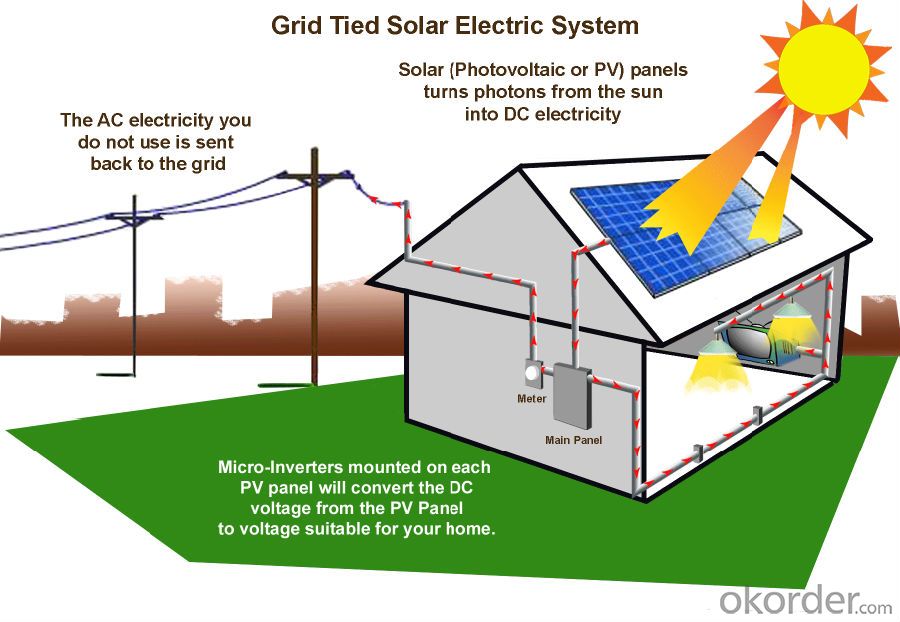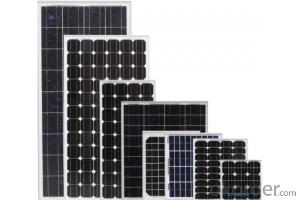Solar Panel Solar Module PV Solar With UL TUV Certificates 315w
- Loading Port:
- Shanghai
- Payment Terms:
- TT OR LC
- Min Order Qty:
- 1 watt
- Supply Capability:
- 10000000 watt/month
OKorder Service Pledge
OKorder Financial Service
You Might Also Like
Item specifice
Solar panel material
1. glass
Its main role is to protect the power generation ( solar cells ) , there is a selection of light transmittance requirements : 1 ) must be high transmittance (typically 91% or more ) ; 2 ) super white steel processing.
2. EVA
For bonding glass and power generation fixed body ( such as cells ) , transparent EVA material directly affect the life of components exposed to the air EVA prone aging yellow , thus affecting the transmittance components , thus affecting in addition to generating the quality of the components itself, the quality EVA lamination process on the component manufacturers is also very large, such as EVA plastic viscosity of non-compliance , EVA and glass, back bonding strength is not enough, can cause premature aging EVA, the affected component life.
3. Solar cells
The main role is to generate electricity , the electricity is the main market mainstream film crystalline silicon solar cells , thin-film solar cells , both have their advantages and disadvantages . Crystalline silicon solar cells , the equipment costs are relatively low , but the high cost of consumption and cells , photoelectric conversion efficiency is high, the next generation in outdoor sunlight is more appropriate ; higher thin-film solar cells , the relative cost of equipment , but the cost of consumption and battery low, relatively low photoelectric conversion efficiency of crystalline silicon solar cells , but the effect is very good low-light , in the ordinary light can also generate electricity , such as solar calculator .
4. backplane
Sealing, insulation , water ( usually with TPT, TPE , etc. ) the material must be resistant to aging , component manufacturers generally have warranty for 25 years , tempered glass, aluminum is generally no problem , the key lies in whether the backplane and can meet the requirements of silica gel.

PERFORMANCE
- High effi ciency, multicrystalline silicon solar cells with high transmission and textured glass deliver a module effi ciency of up to 16.0%,
minimizing installation costs and maximizing the kWh output of your system per unit area.
- Tight positive power tolerance of 0W to +5W ensures you receive modules at or above nameplate power and contributes to minimizing
module mismatch losses leading to improved system yield.
Structure of Polycrystalline Silicon Solar Panel Type
Solar modules, which are widely used in ground mounted utility-scale PV plants, large-scale and small civil and commercial power generating system such as BIPV combined to the grid, roof-mounted PV power system, rural electrification, communications, emergency auxiliary power.
Solar PV module is comprised of some solar cells which are connected in serial with high efficiency and enhanced reliability.
Advantages of Monocrystalline Silicon Solar Panel
• CNBM Solar performance guarantees for 25 years
• 12 years guarantee for workmanship
• Timeliness of delivery
• Quality Products certified (TÜV, UL, CE, VDE, ISO)
CNBM International Corporation's products including Monocrystalline Solar Panel, Polycrystalline Solar Panel have received and enjoyed famous reputation in many countries and regions in the world .As a solar panel supplier in China, we strive to provide our customers with excellent service, superior products and unmatched value.
- Q:What is the difference between solar panels and light panels?
- The highest conversion efficiency in the laboratory is 24.7%, and the efficiency of the scale is 16%. Polysilicon conversion rate of 14% -15%. Amorphous silicon conversion rate of 12%. Silicon film conversion rate of 9%. Silicon solar cell is the main raw material of silicon, silicon is an extremely rich element of the earth, almost everywhere there are silicon, can be said to be inexhaustible, with silicon to create solar cells, raw materials can be described as no shortage.
- Q:Green issues aside, are solar panels worth it, monetarily speaking?I don't mean that my house might be worth more or any of that. All I am asking is this: if I invest in a set of solar panels, will the cost be paid back to me over time? If so, how long will it takegt;Take into account the following:. Currently I pay the electric company around $00 per month2. I use around 400 kilowats of energy per monthI realize that exact numbers are hard to come by, but any opinions are welcome.
- There are several factors to consider when looking into solar power for your house. If you want to replace your use of utility electricity with solar power for say a 500 - 2000 square foot home then the system will cost you at least $30000 - $50000 to install. You will also have the maintenance issue of your storage batteries, panels, and inverter which will eventually wear out over time. So lets say we have an optimistic price of $30000 for a whole house system (this would be really cheap), dividing this by your yearly consumption would give you the amount of years it would take for the expenditure to pay for itself (not counting maintenance which could be costly). The payoff would be about 25 years, so all things remaining equal, I would say that it is a bad investment. Solar panels as they are manufactured today do not have a very long life span. They will greatly decrease in efficiency after several years and will most likely need to be replaced in 0 years. The panels themselves are the greatest expense. You could problably find better ways to make/save more money by investing $30000 - $50000 somewhere else IMHO. Solar technology is still not at the point where it is profitable in the sense you are thinking about. Unless of course, there are huge tax incentives for you or large rebate programs through your local utility, but you would have to do the math on that as well. If you are thinking small as in a couple panels to supplement your utility electric, the above still applies as well. In fact will it take longer to recoup the cost of a smaller setup. Hope this helps!
- Q:Can solar panels be used to power swimming pools?
- Yes, solar panels can be used to power swimming pools. Solar panels generate electricity by converting sunlight into energy, which can be used to power various devices and appliances, including swimming pool pumps and heaters. By installing solar panels, pool owners can significantly reduce or eliminate their reliance on traditional electricity sources, making it a sustainable and cost-effective way to power swimming pools.
- Q:Can solar panels be used for powering a wastewater treatment plant?
- Yes, solar panels can be used for powering a wastewater treatment plant. Solar energy can be harnessed and converted into electricity, which can then be used to power the various components and processes involved in wastewater treatment. This renewable energy source helps reduce reliance on non-renewable fuels, lowers operational costs, and minimizes the environmental impact of the treatment plant.
- Q:Why can't they put solar-panels on the blades and sides of the 300-500 foot tall turbines? Wouldn't this increase effeciency? Therefore, boosting pay-back time, profits, energy-output?
- Hmm, okorder /.. Glad to see you thinking though, keep it up! Knowledge is power the more knowledge you gain about a variety of subjects processes the more you truly understand the truth depth of that statement.
- Q:I mean like bread is made of wheat, what are solar panels made up of?How are they manufactured?
- Solar panels (aka photovoltaic panel) are most often made up of thin wafers of crystalline silicon or cadmium telluride. As photons from the sun enter the photovoltaic cell, electrons are freed from the substrate when are then collected by wires that run throughout the panel. And as we know electrons=electricity!
- Q:Can the solar panels available be coated with a material (to improve it's looks) and not alter it's efficiency?
- No. The only coatings I am aware of are those that reduce reflection so more light gets through the protective surface to the actual cells. Anything thing that affects appearance is going to be reflecting light back to the viewer and the photons of that light are not available for electricity or heat. If the appearance of the panels offends you, then they need to be concealed by a fence of panels around them that do not throw shadows on the panels.
- Q:How could I find out what the amp output of a solar panel? Specifically, I want to know how many milliamps can the solar panel on a Casio fx-260 put out?
- You need full sunshine from the sun, or a lamp that will give a light spectrum similar to the sun, a volt meter, Milli-amp meter, and a variable resistor of 0 to 000 ohms. The voltmeter test leads go across the solar cell leads. The amp meter leads will be in series with the solar cell. Let's say, positive lead of the solar cell to the the positive lead of the amp meter, the negative lead of the amp meter to one terminal of the variable resistor, and the wiper terminal of the variable resistor to the negative lead of the solar cell. Slowly decrease the value of the resistor until the voltage from the solar cell just begins to drop. Take note of the amp meter reading. This is about the high end range of the solar cell. You might want to begin with a micro-amp meter for the current meter.
- Q:How much solar energy does a 2m by a 3m solar panel convert to energy on a sunny day? Assume that the solar cells are 30% efficient.I'm not looking for the answer so much as I need an explanation o how to solve this type of problem... Thanks!!
- A watt is the fee at which vigour is produced. It's analogous with horsepower, hp = 745W= 33,000 toes-lbs per minute. So the wattage of a sunlight panel is the capacity of the panel to drive a procedure like run a motor or power a radio. General energy calculations are a part of the bigger class of Physics.
- Q:Can solar panels be installed on military bases or installations?
- Yes, solar panels can be installed on military bases or installations. In fact, many military bases around the world have already incorporated solar energy as a part of their sustainability initiatives. Installing solar panels on military bases not only helps reduce their reliance on traditional energy sources but also enhances their energy security and resilience.
1. Manufacturer Overview |
|
|---|---|
| Location | |
| Year Established | |
| Annual Output Value | |
| Main Markets | |
| Company Certifications | |
2. Manufacturer Certificates |
|
|---|---|
| a) Certification Name | |
| Range | |
| Reference | |
| Validity Period | |
3. Manufacturer Capability |
|
|---|---|
| a)Trade Capacity | |
| Nearest Port | |
| Export Percentage | |
| No.of Employees in Trade Department | |
| Language Spoken: | |
| b)Factory Information | |
| Factory Size: | |
| No. of Production Lines | |
| Contract Manufacturing | |
| Product Price Range | |
Send your message to us
Solar Panel Solar Module PV Solar With UL TUV Certificates 315w
- Loading Port:
- Shanghai
- Payment Terms:
- TT OR LC
- Min Order Qty:
- 1 watt
- Supply Capability:
- 10000000 watt/month
OKorder Service Pledge
OKorder Financial Service
Similar products
New products
Hot products
Hot Searches
Related keywords





























